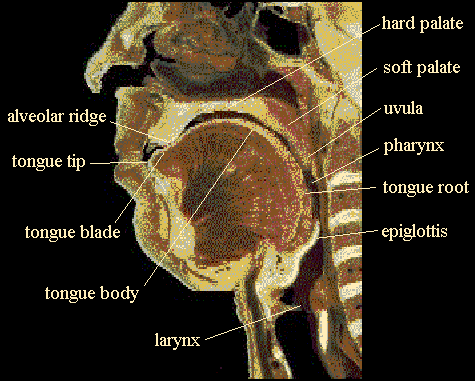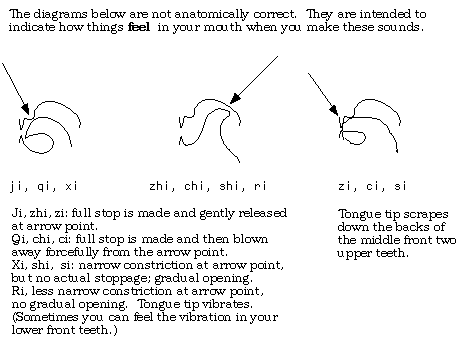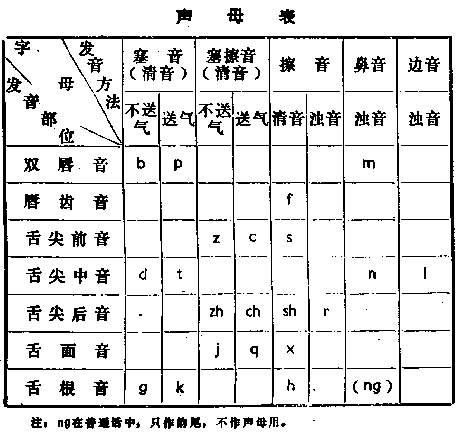Phonetics
Phonetics is the branch of linguistics which deals with how the different sounds of language are produced. Phonetics uses a lot of jargon which may seem intimidating, but it’s really not very complicated at all. The average person should be able to follow my linguistic explanations. First, look at the image below (taken from the University of Manitoba site).
My goal here is only to explain the the sounds in Mandarin represented in pinyin as j, q, x, and r. In discussing making these sounds, I’ll need to refer to the tongue tip, tongue blade, alveolar ridge, and hard palate.
Most of the misconceptions about Chinese’s j, q, and x sounds arise because those sounds are compared to English’s “j,” “ch,” and “sh,” respectively. In fact, all six sounds are called palatals in linguistic terms because they are all produced with the tongue on or near the hard palate. The similarity, however, ends there.
The main difference lies in the fact that the tongue tip is in different places for these two sets. For English’s “j,” “ch,” and “sh,” the tongue tip is usually on the hard palate just behind the alveolar ridge. For Mandarin’s j, q, and x, the tongue tip rests against the base of the lower front teeth (right about on the gum line), while the tongue blade presses up against the alveolar ridge and produces the sound. Refer to the image below (taken from Patrick Moran’s site at Wake Forest University).
Because it is the tongue blade producing the sound and not the tongue tip, Mandarin’s j, q, and x sounds are different from any sounds in the English language. This kind of sound has a special name: a “dorsal.”
The linguistic terms “palatal” and “dorsal” may seem confusing to you, but in Chinese they are extremely simple and quite illuminating. The Chinese word for “dorsal” is “she mian yin.” Translated literally, it means “tongue surface sound” — a sound produced using the surface of the tongue, or tongue blade (not the tongue tip).
Mandarin’s zh, ch, and sh, on the other hand, are all “she jian hou yin” in Chinese (“tongue tip back sound”), because the tongue tip is in the back of the mouth (see the diagram above). Clearly, the two groups are quite distinct. Below is a Chinese linguistic chart of pinyin’s consonants (taken from Hao Ran Kaoshi Wang)
[This site has a clearer version of this chart in Chinese text.]
Since I brought them up, I suppose I should touch on Mandarin’s zh, ch, and sh sounds. These sounds are not quite the same as English’s “j,” “ch,” and “sh,” but they’re not terribly different. The difference is that in English those sounds are produced by placing the tip of the tongue just behind the alveolar ridge, whereas in Chinese the tongue tip is farther back, way past the alveolar ridge. Because the tongue is bent back so far, these sounds, along with Mandarin’s r, are called “retroflex“.
If zh and “j,” ch and “ch,” sh and “sh” are not so terribly different, then why should you worry about it all? Actually, if you are pronouncing Mandarin’s vowels correctly, you’ll end up with your tongue pretty much in the right place naturally. As I mentioned in the Background section:
A good way to learn to say the very important Chinese word shi is to start to say the English word “shirt” but stop right as the “r” sound is beginning. Once you can say shi, apply that vowel sound also to pinyin si, ci, chi, zi, zhi, ri.
When you say the word “shirt” in English, your tongue starts out on the alveolar ridge but then pulls back to make the “r” sound. It is this “pulled back” position where your tongue needs to be for Mandarin’s retroflex sounds. If you can start the “sh” sound already in the pulled back position, then you’re making Mandarin’s sh sound correctly. Mandarin’s ch and zh sounds are made in the exact same tongue position.
Mandarin’s r is also more or less made in the same place, but it can be a bit tricky because English doesn’t have any sounds like it. The American “r” is usually made by bunching up the tongue in the back of the mouth. If you make an “r” sound you can feel it bunch up. The tongue tip is doing nothing. When producing Mandarin’s r sound, the tongue does not bunch up, and the tongue tip produces the sound (again, see Patrick Moran’s illustration above).
The thing is, Chinese people probably won’t have trouble understanding if you make the Mandarin r sound the American way. That is, until you try to say “riben” (“Japan”). You just can’t make it sound right at all using the American “r.” You must learn to produce the retroflex r. Then apply it to Mandarin’s other r‘s.
These new sounds (j, q, x, r in particular) will feel very awkward at first, and if you’ve been producing them incorrectly for some time already, the crossover will take some time. Be patient with yourself, and be diligent in your pronunciation. The rewards will come eventually, as your Mandarin starts to sound more and more authentic.
For IPA symbols of Mandarin’s unique sounds in a complete chart together with pinyin, go here.
The next section will essentially explain how to produce these same sounds, but in more detail regarding tongue positions, and with less linguistic jargon.
NOTE: John’s more recent efforts at pronunciation practice are available on the AllSet Learning Store. Check it out!



